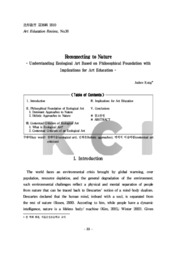

PARTNER
검증된 파트너 제휴사 자료
Reconnecting to Nature - Understanding Ecological Art Based on Philosophical Foundation with Implications for Art Education -
28 페이지
최초등록일 2025.06.27
최종저작일
2010.04

-
미리보기
서지정보
· 발행기관 : 한국조형교육학회
· 수록지 정보 : 조형교육 / 36호 / 33 ~ 60페이지
· 저자명 : 강주희
초록
After reviewing Linda Hall's work based on philosophical foundations, I discovered that many features of the relationship between the artist, their artworks, and environmental issues have the potential to inform the discipline and practice of art education. It can be useful for Korean art education.
Thematically, the ecological art is based on artist's experiences in the natural environment, and reflect the relationship with nature. The ecological artist often exposes himself/herself to nature, and place a great value on such direct encounters. Through the artworks, they foster a conversation between the viewer and nature by expressing their own interactions with nature beyond just their depictions of it. Ecological artwork gives a voice to nature, which has been suffering from un-mindful development by humans. In this context, Rosenthal (2003) proposed that “teaching environmental art provides a venue for integrating the disciplines and promoting systems thinking” (p. 153). She described visual art as “the study and creation of relationships, patterns, and possibilities, including the formal relationships of line, form, and color; exchanges between people and within societies; and the interdependences of human and non-human nature” (p.154). In this study, the holistic worldview of the artist, and the way in which they manifested this worldview in the art, can inform art education practices. In reconnecting the mind and body, and encouraging positive experiences with nature, teachers create a natural motive for even more environmentally-friendly action. Teachers can begin with local issues and then easily extend the students’ awareness to global issues, since involvement with local issues often naturally leads to global issues. According to Blandy, Congdon, and Krug (1998), this sort of art education of place, based as it is on the local community, “promotes the values of diversity, collaborative and cooperative working relationships, and consensus building” (p. 241).
The artwork studied depict nature as a spiritual force that can provide us with positive energy. The artist’ attitude toward the natural environment is evident in her work. The ecological artist demonstrated a strong moral code in relation to their affinity toward nature, and a perception that environmental problems are largely the result of un-mindful development. For students to cultivate a moral reasoning and affinity toward nature, understanding and learning about ecology, community, and place should accompany lessons about art on the basis of philosophical understanding.
Ecological arts often emphasize our responsibility in acting to mitigate environmental problems as well as knowledge about the natural environment helps to build a sense of place. The more students know, the more they will care. Just as with the artists in this study, students can learn about ecology in the process of making art. At the very least, they can recognize what kinds of animals and plants live with us and apply an appreciation for the broader natural world in their artworks.
In terms of environmental issues, art also can be the stimulus for a great communal effort. Because the ecological artist communicates with people through their artworks, s/he stimulates questions about our relationship with the environment and environmental problems. By making connections to their own life issues and experiences, art educators can help students identify and give voice to the questions that arise when they view ecological art.
Art can create a bridge between students and local environmental issues that can lead to communication with neighbors in the community. According to Graham (2006), school “tends to ignore the peculiarities of place, culture, and community in order to standardize the experience of students” (p. 1). Studying the ecological artists and their work suggests ways that the educator might resist the isolation of the classroom from vital issues of community and ecology by focusing on the peculiarities of the local environment and culture.참고자료
· 없음태그
-
자주묻는질문의 답변을 확인해 주세요

꼭 알아주세요
-
자료의 정보 및 내용의 진실성에 대하여 해피캠퍼스는 보증하지 않으며, 해당 정보 및 게시물 저작권과 기타 법적 책임은 자료 등록자에게 있습니다.
자료 및 게시물 내용의 불법적 이용, 무단 전재∙배포는 금지되어 있습니다.
저작권침해, 명예훼손 등 분쟁 요소 발견 시 고객센터의 저작권침해 신고센터를 이용해 주시기 바랍니다. -
해피캠퍼스는 구매자와 판매자 모두가 만족하는 서비스가 되도록 노력하고 있으며, 아래의 4가지 자료환불 조건을 꼭 확인해주시기 바랍니다.
파일오류 중복자료 저작권 없음 설명과 실제 내용 불일치 파일의 다운로드가 제대로 되지 않거나 파일형식에 맞는 프로그램으로 정상 작동하지 않는 경우 다른 자료와 70% 이상 내용이 일치하는 경우 (중복임을 확인할 수 있는 근거 필요함) 인터넷의 다른 사이트, 연구기관, 학교, 서적 등의 자료를 도용한 경우 자료의 설명과 실제 자료의 내용이 일치하지 않는 경우
“조형교육”의 다른 논문도 확인해 보세요!
-
Ruining Representation: Barbara Kruger's Text-and-Image Montage 19 페이지
Kruger's text-and-image montage is a postmodern critique of stereotypes, embedded in representations of women in particular. The rupture between her own texts and borrowed photographic images generate.. -
그래스볼과 블룸의 정의적 영역 학습목표 모형 비판 24 페이지
본 연구는 첫째, 그래스볼과 블룸의 “정의” 개념에는 감정은 체험된다는 사실이 학습목표로 제시되어 있지 않다. 정의의 개념 뜻에 인지적 판단과 함께 마찬가지로 감정은 “체험된다”는 부분을 학습목표에 적용해야 한다. 이는 불확실한 감정을 표현하고 미적 감정을 체험하는 능력, 이를 통한 능동적 감정조절과 발달을 꾀할 수 있다는 측면에서 필요하다. 즉, 정의적 ..
문서 초안을 생성해주는 EasyAI
